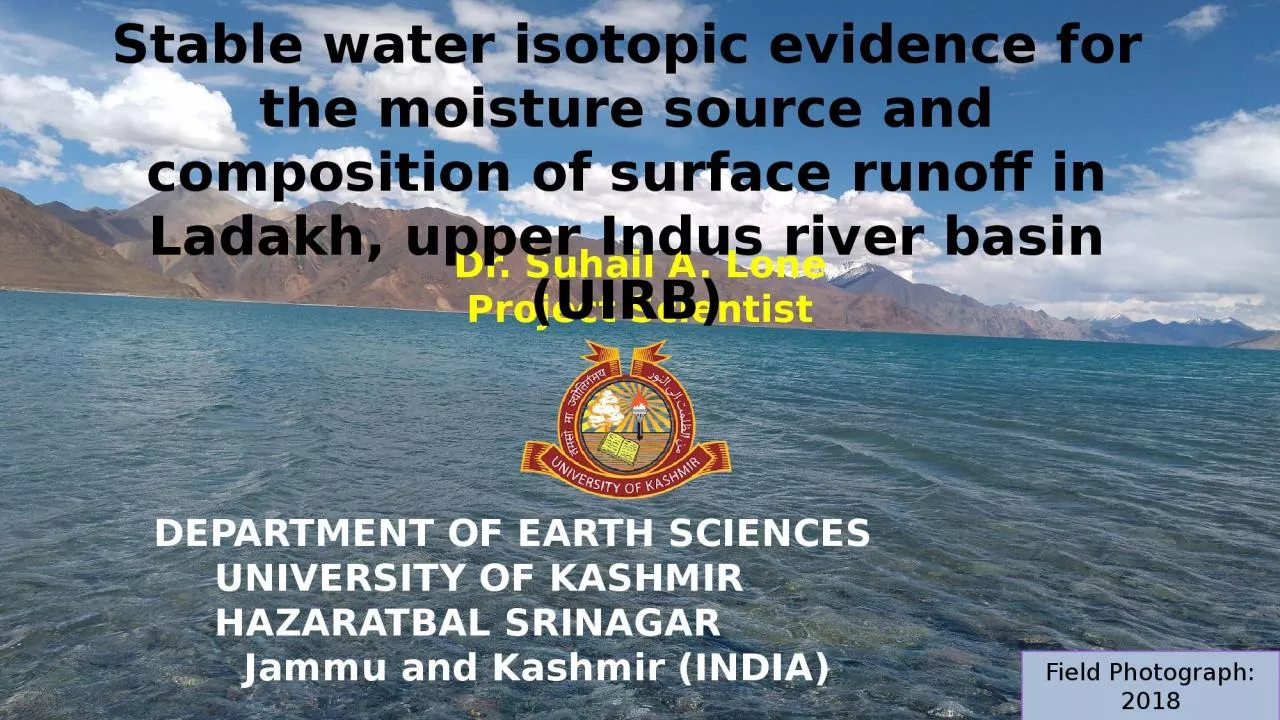

Project Scientist DEPARTMENT OF EARTH SCIENCES UNIVERSITY OF KASHMIR HAZARATBAL SRINAGAR Jammu and Kashmir INDIA Stable water isotopic evidence for the moisture source and composition of surface runoff in Ladakh upper Indus river basin UIRB ID: 1026536
Download Presentation The PPT/PDF document "Dr. Suhail A. Lone" is the property of its rightful owner. Permission is granted to download and print the materials on this web site for personal, non-commercial use only, and to display it on your personal computer provided you do not modify the materials and that you retain all copyright notices contained in the materials. By downloading content from our website, you accept the terms of this agreement.
1. Dr. Suhail A. LoneProject Scientist DEPARTMENT OF EARTH SCIENCES UNIVERSITY OF KASHMIR HAZARATBAL SRINAGAR Jammu and Kashmir (INDIA)Stable water isotopic evidence for the moisture source and composition of surface runoff in Ladakh, upper Indus river basin (UIRB)Field Photograph: 2018Pangong Lake
2. More than 1/6 of worlds population depends on snow and glacier fed rivers.Known as Water Tower of AsiaLargest body of glaciers outside of polar regions, occupy 17% of mountain area (IPCC, 2007) hence also know as Third pole.5000 glaciers in Himalayan-Hindu-Kush region with an area of 35,110 km2.1800 glaciers in J&K, cover an area of 997 km2. Satellite image of Himalayan CryosphereHimalayan Cryosphere
3. SignificanceThese Glacier/Snow fed rivers supply fresh water to 500 million in Himalayas-Hindu-Kush region and 250 million people in China (IPCC,2007)Drinking PurposesAgricultureHydropower generationShrinking cryosphere?????Concern among the peopleClimate Change: everybody's cup of tea
4. Area: 59942 sq. kmsElevations: 2500 a,msl in Drass to > 5000 m a,msl in LehClimate: Cold arid climate annual precipitation of about 115 mm (Weather station Leh)Temperature: 14oC in summer to -8oC in winter (Weather station Leh)Study Area
5. Upper Indus river basin LadakhLong-term temperature and precipitation trendsIMD and NOAASource: Lone et al., 2019
6. Variation of δ18O and δ2H in precipitationδ18O vs. air temperature, precipitation amount & d-excessLMWL-Precipitation (Monthly & Seasonal)δ18O vs. Altitude
7. The stable water isotopic value of precipitation abruptly drops at all the precipitation sites in August, without considerable variation in the ambient temperature and precipitation amount signifying the alteration in moisture source.
8. NCEP/NCAR (National centre for environmental prediction/National centre for atmospheric research:Westerly wind dominant from the October to May.southwest monsoons dominant from June to September.
9. HYSPLIT Model100015002000
10. Machoi and Galdar glaciers exhibit low isotopic values: δ18O or / δ2H -10.4 to -12‰ and -73 to -74‰, than Parachik, Drung-Durung and Khardung glaciers (Avg:: δ18O or / δ2H -13.6 to -16.8‰ and -95 to -110‰).Isotope altitude gradient (-0.27 ‰ and -2 ‰) for δ18O and δ2H.δ18O and δ2H v/s altitude in glacier meltTemporal variation in glacier meltStable isotopic variation (δ18O and δ2H) in glacier melt
11. Snowpack samples taken from the winter-accumulated snowpacks along various transects in all the basins ranged from −15.38 to−11.48 ‰ (S.D.: 1.6) and −112.76 to −70.28 ‰ (S.D.: 12.2) with an average values of −94.05‰ and −13.43‰.The estimated isotope altitude gradient of snowpack samples varied from −0.24 to −0.42 ‰ and −2.4 to −3.9‰ for δ18O and δ2H.Stable isotopic variation (δ18O and δ2H) in snowpacks:δ18O and δ2H v/s altitude in glacier meltTemporal variation in glacier melt
12. Stable isotopic variation (δ18O and δ2H) in Stream waterδ18O & δ2H variation in stream water in different rivers of upper Indus basinTemporal variation of δ18O & δ2H in stream water in different rivers of upper Indus basin
13. Relation between LMWL & GMWLThe slope of all stream water is higher than LMWL but lower than GMWL.Dras river: δ2H=7.6(±0.8)˟δ18O+23(±3.2) R2=0.98Suru river: δ2H=8.6(±0.6)˟δ18O+18(±2.8) R2=0.95Shyok river:δ2H=9.6(±0.4)˟δ18O+16(±2.1) R2=0.81Nubra river:δ2H=8.2(±0.7)˟δ18O+14(±3.3) R2=0.93Indus river:δ2H=7.7(±0.3)˟δ18O+13(±2.2) R2=0.86
14. Contribution from rain, snow, glacier melt and groundwater to regional hydrology:
15. The contribution of rain, snow, glacier melt and groundwater to stream flow in different rivers of Ladakh (UIRB) with uncertaintyContribution from rain, glacier melt, snowmelt and groundwater in (%):RiversSpringSummerAutumnrsngmgwrsngmgwrsngmgwDras12±0.241±1.230±1.418±0.822±0.936±1.631±1.711±0.118±0.825±1.141±2.116±0.2Suru14±0.439±1.932±1.115±0.219±0.733±1.926±1.512±1.110±0.121±0.649±2.720±0.5Indus20±0.437±2.127±0.616±0.624±0.736±1.223±0.717±0.322±0.825±0.937±1.116±0.7Nubra17±1.141±1.927±0.815±0.522±0.937±1.829±1.712±0.316±0.531±0.641±2.312±0.5Shyok18±0.939±1.824±0.419±0.321±0.733±1.733±1.913±0.116±0.828±0.846±2.610±0.2
16. Thank YouThank YouField photograph: 2018Drang-Drung Glacier